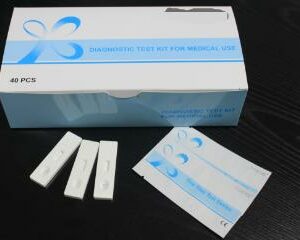Description
[Expected usage]
The crystal is used to detect the new coronavirus N antigen in oropharyngeal swabs and nasopharyngeal swabs from patients with suspected pneumonia caused by new coronavirus infection. Antigen testing is generally used in the acute infection period, that is, samples are tested within 7 days after the suspected patient develops symptoms. Antigen testing cannot be used alone to diagnose new coronavirus infections. The infection should be judged based on diagnostic information such as nucleic acid testing and imaging, medical history, and contact history.
The positive result of the antigen test can be used for early typing and rapid management of suspicious people, but the positive result indicates the presence of new coronavirus N antigen in the sample and cannot be used as a basis for diagnosing new coronavirus infection. A negative result cannot exclude new coronavirus infections, nor can it be used alone as a basis for making treatment and disease management decisions. Suspected people with positive antigens and open results should be further tested for mycolic acid.
This product should not be used for screening of the general population.
This product should be used by professionals in professional laboratories.
To carry out new coronavirus antigen testing, it should meet the requirements of "New Coronavirus Infection Pneumonia Laboratory Testing Technical Specifications" and other requirements, and do a good job of biosafety.
[Main components]
The reagent consists of a test card, sample extraction liquid, sample extraction tube and dripper.
1. Test card: The test card is composed of a test strip and a plastic box: the test strip is composed of nitrocellulose membrane, sample crystal pad, bonding pad, absorbent paper, PVC board and other supports
Composition: Contains 2019-nCoV labeled antibody (mouse, monoclonal antibody) and 2019-nCoV coated antibody (mouse, monoclonal antibody). Goat anti-mouse IgG more
Cloned antibodies.
2. Sample extraction solution: Tris-HCl. Tween-20. Purified water, etc., 6mL/bottle.
Note: The components in the kits of different batch numbers cannot be mixed to avoid false results.
[Sample requirements]
It is recommended to use a polyester sponge swab with a PP (polypropylene) rod as a sterile swab for sample collection.
Throat secretion collection: Insert the swab completely from the mouth into the throat, centering on the throat wall and the reddened area of the palate tonsils, and wipe the bilateral pharyngeal tonsils with moderate force
And the back wall of the pharynx, avoid touching the tongue and remove the swab.
Inspection procedure
1. Sample extraction of oropharyngeal/nasopharyngeal secretions
1. Add 10 drops (about 400uL) of sample extraction solution directly before the sample extraction tube.
Physical technology
2. Insert the swab from the collection of pharyngeal/nasopharyngeal secretions into the sample extraction tube solution, rotate it close to the inner wall of the test tube 10 times, and let it stand for 1 min to make Xiangben as dissolved
In solution.
3. Squeeze the tip of the swab along the inner wall of the extraction tube to keep the liquid in the tube as much as possible, take out and discard the swab.
4. Cover the dripper.
5. When using the virus sampling solution to collect samples, you can refer to the corresponding operating instructions and put the swab after sampling into the sampling tube: the part of the sample that is higher than the sampling tube is broken and tightened
Cap the tube and shake well.
Specification:1T




